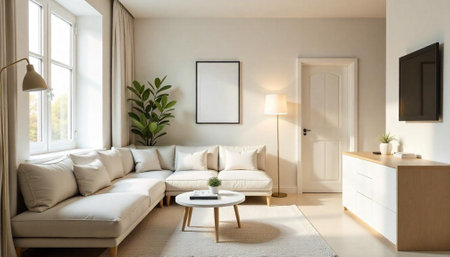Understanding Qi Flow and Why Natural Light Matters
From a Feng Shui perspective, Qi refers to the vital energy that flows through our living environments, influencing wellbeing, comfort, and overall harmony. In the context of British homes—especially those in the UK where natural light can be limited by weather and architectural style—maximising the flow of Qi becomes both a practical and cultural consideration. Traditional UK living rooms often feature smaller windows or are positioned in ways that may inadvertently restrict daylight. By focusing on enhancing natural light, we not only improve the brightness and mood of our spaces but also align with Feng Shui principles that associate healthy Qi flow with good fortune and vitality. In essence, understanding how light interacts with space is foundational to creating a living room that feels open, balanced, and energetically supportive within the unique climate and architecture of the UK.
2. Assessing Natural Light in Typical UK Living Rooms
When aiming to maximise natural light for optimal Qi flow, it is crucial to first understand the unique characteristics of British living rooms. The typical UK home, especially those built before the 21st century, often faces several architectural and environmental challenges that can hinder effective daylight penetration.
Common Challenges in British Architecture
British homes are frequently constructed with thick brick or stone walls, relatively small windows, and sometimes even deep window reveals. These features, while excellent for insulation and privacy, often restrict the amount of sunlight entering the living space. Furthermore, older terraced or semi-detached houses may have only one main external wall with windows, limiting light flow into the room.
Window Placements and Orientation
The placement and orientation of windows significantly impact natural light levels. North-facing rooms tend to receive cooler, indirect light throughout the day, while south-facing rooms enjoy more consistent sunlight—though this varies greatly depending on obstructions like neighbouring buildings or mature trees. Bay windows, sash windows, and patio doors each provide different benefits and limitations regarding daylight entry.
| Room Orientation | Natural Light Quality | Common Issues |
|---|---|---|
| North-facing | Consistent but cool, subdued light | Can feel gloomy; limited direct sunlight |
| South-facing | Bright, warm light most of the day | Possible glare; overheating in summer |
| East-facing | Morning sunlight; fades by afternoon | Dull in late afternoon/evening |
| West-facing | Soft morning light; strong afternoon/evening sun | Uneven lighting; possible glare late in day |
The Impact of UK Weather on Natural Light Availability
The UKs famously unpredictable weather also plays a vital role. Overcast skies are common for much of the year, reducing overall brightness indoors. Even well-placed windows might not suffice on consistently grey days, making it essential to assess both architectural factors and local climate when planning for optimal Qi flow through natural light maximisation.

3. Practical Ways to Maximise Natural Light
Enhancing natural light in your UK living room is not only about aesthetics but also about fostering positive energy flow, or Qi, within your home. The often overcast British weather and traditional architectural features—think bay windows and chimney breasts—present both challenges and opportunities. Here are some tried-and-tested methods, thoughtfully adapted for the unique character of UK living spaces.
Choose Light Colours for Walls and Furnishings
Pale shades such as off-white, soft greys, and muted pastels reflect more daylight, immediately brightening any space. In the UK, where natural light can be limited especially during winter months, opting for these tones on walls, ceilings, and large furniture pieces helps amplify whatever sunlight is available. Consider using eggshell or satin finishes for added luminosity without excessive glare.
Select Appropriate Window Dressings
Heavy drapes might suit a stately manor, but they often block precious daylight in more modest homes. Instead, lightweight fabrics like linen or cotton voiles allow sunlight to filter through while still providing privacy—a practical solution for terraced houses with close neighbours. For period properties with sash windows, consider shutters that can be adjusted throughout the day to balance light and privacy needs.
Strategically Place Mirrors
Mirrors are a classic technique for increasing perceived brightness and encouraging better Qi flow. In UK living rooms where windows are frequently positioned on one wall, placing a large mirror opposite or adjacent to a window reflects incoming light deeper into the room. Be mindful of what is reflected: avoid doubling up clutter or dark corners, instead aim to mirror views of greenery outside or bright open spaces within the room.
By making informed choices tailored to the realities of British homes—be it a Victorian terrace or a modern flat—you can create an environment that feels lighter, brighter, and more harmonious. Each small adjustment contributes not just to improved natural lighting but also to a balanced and uplifting atmosphere in line with optimal Qi flow principles.
Cultural Considerations for UK Homes
When maximising natural light in UK living rooms for optimal Qi flow, it’s crucial to factor in the unique aspects of British culture, lifestyle, and architecture. British homes—ranging from Victorian terraces to modern flats—come with specific privacy concerns, period property quirks, and established daily routines that influence lighting choices. Below, I break down the key considerations and practical approaches for integrating more daylight while respecting local traditions and requirements.
Factoring in British Lifestyle
The UK’s variable weather and shorter daylight hours during autumn and winter mean that making the most of available sunlight is both a necessity and a challenge. Many Brits value their living rooms as multi-functional spaces for relaxation, entertaining guests, or family time. Thus, flexibility in lighting solutions is essential. For example, combining sheer curtains with adjustable blinds allows you to control brightness according to changing light conditions throughout the day without compromising comfort.
Privacy Concerns
Privacy is a significant aspect of British home life. Large windows or glass doors may invite unwanted attention from passers-by, especially in urban areas or terraced streets. The table below summarises some common privacy solutions that balance natural light with discretion:
| Solution | Light Maximisation | Privacy Level |
|---|---|---|
| Sheer Curtains | High | Moderate |
| Frosted Window Film | Medium | High |
| Venetian Blinds (tilted) | Adjustable | Adjustable |
| Café-style Shutters | Medium-High | High (lower half) |
Period Property Quirks
The charm of many UK homes lies in their historical features—bay windows, deep sills, or stained glass panels—which can present both opportunities and challenges for maximising light. For instance, original sash windows often have smaller panes or thicker frames that reduce direct sunlight. In these cases, using mirrors strategically placed opposite windows can amplify available daylight. When working with listed properties or those in conservation areas, always check local regulations before making structural changes.
Summary: Respecting Tradition While Enhancing Qi Flow
The key to success lies in blending modern lighting techniques with respect for British home culture and architectural heritage. By thoughtfully addressing lifestyle habits, privacy needs, and historic details, you can create living rooms that are not only brighter but also harmonious environments supporting optimal Qi flow.
5. Seasonal Adjustments and Maintenance
Adapting your living room for the UK’s famously variable climate is essential to maximising natural light and sustaining optimal Qi flow throughout the year. The long, dark winters and unpredictable weather patterns demand a flexible approach, where your space evolves with the seasons rather than fighting against them.
Embracing the Winter Months
During winter, when daylight hours are at their shortest, it’s crucial to position mirrors strategically to capture and reflect every available ray of sunlight. Opt for lighter-coloured walls and soft furnishings in creams, pale greys or gentle blues, which help bounce light around the room and keep energy from stagnating. Consider swapping out heavy curtains for lighter voiles or layered blinds that can be opened wide during rare sunny spells but still offer warmth and privacy in the evenings.
Supplementing Natural Light
Even with your best efforts, natural light may be limited during the UK winter. Integrate warm-toned LED lamps or daylight bulbs positioned at varying heights to mimic the sun’s trajectory and reduce harsh shadows. Favour lampshades made from linen or cotton to diffuse artificial light softly, supporting an uplifting and calming atmosphere aligned with Feng Shui principles.
Responding to Changing Weather
The UK’s weather can shift rapidly, so versatility is key. Keep windowsills clear of clutter to allow quick adjustments—opening curtains fully on bright days or closing them against sudden downpours. Regularly clean window panes to prevent grime build-up that can dull incoming light; a monthly wipe-down is often sufficient for most urban homes.
Routine Décor Refresh
Seasonal shifts are an opportunity for minor décor updates: swap cushion covers or throws to reflect the time of year—think woollen textures in winter and lighter cottons or linens in spring and summer. Rotate indoor plants according to available sunlight, ensuring they don’t block vital windows but instead enhance freshness and vitality within your living space.
By staying mindful of these seasonal nuances and maintaining both practical lighting solutions and adaptable décor, you create a resilient living room environment that honours both British weather realities and the smooth flow of Qi essential for comfort and wellbeing.
6. Bringing It All Together: Creating a Harmonious Space
Integrating natural light, functional design, and the principles of Qi into your UK living room requires a balanced approach that values both aesthetics and wellbeing. Start by considering how each element in your space contributes to the flow of energy. Select furnishings with clean lines and natural materials, such as oak or wool, which not only echo the British appreciation for craftsmanship but also support positive Qi. Opt for lighter paint colours—think soft greys, warm creams, or gentle sage greens—to amplify daylight and create an uplifting atmosphere. Position mirrors to reflect incoming sunlight deeper into the room without directly facing doors or windows, which can disrupt Qi rather than enhance it.
Aesthetic Choices That Enhance Light
Choose window treatments that allow flexibility: linen blinds or sheer curtains are ideal for diffusing harsh light while maintaining privacy—a practical nod to the UK’s variable weather. Keep clutter to a minimum; open shelving with thoughtfully curated books and ornaments helps energy circulate freely. Incorporate plants native to Britain, like English ivy or ferns, to soften hard edges and improve air quality, further supporting harmonious energy flow.
Functional Improvements for Daily Comfort
Arrange seating to encourage conversation and connection, with sofas and chairs angled towards both the main source of natural light and each other. Use layered lighting solutions—floor lamps, table lamps, and wall lights with warm bulbs—to supplement daylight on overcast days, ensuring your living room remains inviting year-round. Consider practical additions such as draught excluders or double-glazing to retain warmth without sacrificing brightness.
Applying Qi Principles for Lasting Balance
Finally, apply core Qi principles by keeping pathways clear and avoiding sharp corners directed at seating areas. Place meaningful objects—family photos, local ceramics, or artwork—in positions where they receive natural light but don’t overcrowd surfaces. By weaving together these aesthetic decisions, functional upgrades, and energetic considerations, you’ll create a UK living room that feels spacious, luminous, and deeply balanced—a true sanctuary that nurtures both body and mind.


